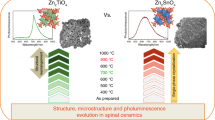Abstract
This work focuses on the construction of a series of novel chemically bonded inorganic–organic rare earth hybrid materials using 3,4-bis(pyridin-4-ylmethoxy)benzoic acid as an organic bridge molecule that can both coordinate with rare earth ions and form an inorganic network with titanium isopropylate and aluminum isopropylate after cohydrolysis and copolycondensation through a sol–gel process. Measurements of the properties of these materials show that the terbium systems present high thermal stability and amorphous structure features. UV excitation in the organic component resulted in strong green emission from Tb3+ ions due to an efficient ligand-to-metal energy-transfer mechanism.
Graphical Abstract








Similar content being viewed by others
References
Sabbatini N, Guardigli M, Lehn JM (1993) Luminescent lanthanide complexes as photochemical supramolecular devices. Coord Chem Rev 123:201–228
Dirr S, Wiese S, Johannes HH, Ammermann D, Bohler A, Grahn W, Kowalsky W (1997) Luminescence enhancement in microcavity organic multilayer structures. Synth Met 91:53–56
Carlos LD, Ferreira RAS, Bermudez VDZ, Ribeiro SJL (2009) Lanthanide-containing light-emitting organic–inorganic hybrids: a bet on the future. Adv Mater 21:509
Kido J, Okamoto Y (2002) Organo lanthanide metal complexes for electroluminescent materials. Chem Rev 102:2357
Weissman SI (1942) Intramolecular energy transfer the fluorescence of complexes of europium. J Chem Phys 10:214–217
Matthews LR, Knobbe ET (1993) Luminescence behavior of europium complexes in sol–gel derived host materials. Chem Mater 5:1697–1700
Binnemans K (2009) Lanthanide-based luminescent hybrid materials. Chem Rev 109:4283–4374
Carlos LD, Ferreira RAS, Bermudez VD (2011) Progress on lanthanide-based organic–inorganic hybrid phosphors. Chem Soc Rev 40:536–554
Harreld JHA, Esaki G, Stucky D (2003) Low-shrinkage, high hardness, and transparent hybrid coatings: poly(methyl methacrylate) cross-linked with silsesquioxane. Chem Mater 15:3481–3489
Sanchez C, Soler-Illia GJDA, Ribot F, Lalot T, Mayer CR, Cabuil V (2001) Designed hybrid organic-inorganic nanocomposites from functional nanobuilding blocks. Chem Mater 13:3061–3083
Tanner PA, Yan B, Zhang HJ (2000) Preparation and luminescence properties of sol–gel hybrid materials incorporated with europium complexes. J Mater Sci 35:4325
Koslova NI, Viana B, Sanchez C (1993) Rare-earth-doped hybrid siloxane-oxide coatings with luminescent properties. J Mater Chem 3:111
Viana B, Koslova N, Aschehoug P, Sanchez C (1999) Optical properties of neodymium and dysprosium doped hybrid siloxaneoxide coatings. J Mater Chem 5:719–722
Choi J, Tamaki R, Kim SG, Laine RM (2003) Organic/inorganic imide nanocomposites from aminophenylsilsesquioxanes. Chem Mater 15:3365
Franville AC, Zambon D, Mahiou R (2000) Luminescence behavior of sol–gel-derived hybrid materials resulting from covalent grafting of a chromophore unit to different organically modified alkoxysilanes. Chem Mater 12:428–435
Li HR, Liu P, Wang YG, Zhang L, Yu JB, Zhang HJ, Liu BY, Schubert U (2009) Preparation and luminescence properties of hybrid titania immobilized with lanthanide complexes. J Phys Chem C 113:3945–3949
Cuan J, Yan B (2014) Luminescent lanthanide-polyoxometalates assembling zirconia–alumina–titania hybrid xerogels through task-specified ionic liquid linkage. RSC Adv 4:1735–1743
Zhang Q, Sheng Y, Zheng KY, Qin XM, Ma PC, Zou HF (2015) Novel luminescent lanthanide complexes assembling alumina/titania/silica hybrids through 2-phenylmalonic acid linkage. J Non-Cryst Solids 413:34–38
Yan B, Li YJ (2011) Photoactive lanthanide (Eu3+, Tb3+) centered hybrid systems with titania (alumina)-mesoporous silica based hosts. J Mater Chem 21:18454–18461
Saif M, Abdel-Mottaleb MSA (2008) Titanium dioxide nanomaterial doped with trivalent lanthanide ions of Tb, Eu and Sm: preparation, characterization and potential applications. Inorg Chim Acta 360:2863–2874
de Faria EH, Ciuffi KJ, Nassar EJ, Vicente MA, Trujillano R, Calefi PS (2010) Novel reactive amino-compound: tris(hydroxymethyl)aminomethane covalently grafted on kaolinite. Appl Clay Sci 48:516–521
Soares-Santos PCR, Nogueira HIS, Félix V, Drew MGB, Ferreira RAS, Carlos LD, Trindade T (2003) Novel lanthanide luminescent materials based on complexes of 3-hydroxypicolinic acid and silica nanoparticles. Chem Mater 15:100
Teotonio ES, Espínola JGP, Brito HF, Malta OL, Oliveria SF, de Foria DLA, Izumi CMS (2002) Influence of the N-[methylpyridyl] acetamide ligands on the photoluminescent properties of Eu(III)-perchlorate complexes. Polyhedron 21:1837
Li Y, Guo M, Yan B (2012) Photoluminescent Eu3+/Tb3+ hybrids from the copolymerization of organically modified silane. Colloid Polym Sci 290:1765–1775
Acknowledgments
This present work was financially supported by the National Natural Science Foundation of China (Grant Nos. 51272085 and 21171066) and the key technology and equipment of efficient utilization of oil shale resources (No. OSR-05).
Author information
Authors and Affiliations
Corresponding author
Rights and permissions
About this article
Cite this article
Zhang, Q., Sheng, Y., Zheng, K. et al. New kinds of hybrid materials containing covalently bonded Tb3+ (Eu3+) complexes organically modified titania and alumina network via sol–gel process. J Sol-Gel Sci Technol 77, 152–159 (2016). https://doi.org/10.1007/s10971-015-3839-5
Received:
Accepted:
Published:
Issue Date:
DOI: https://doi.org/10.1007/s10971-015-3839-5




